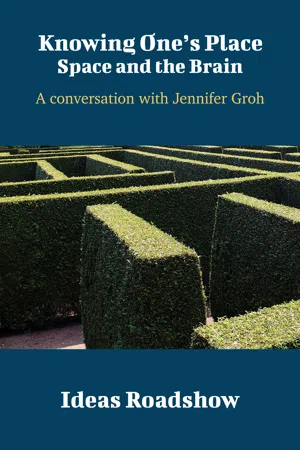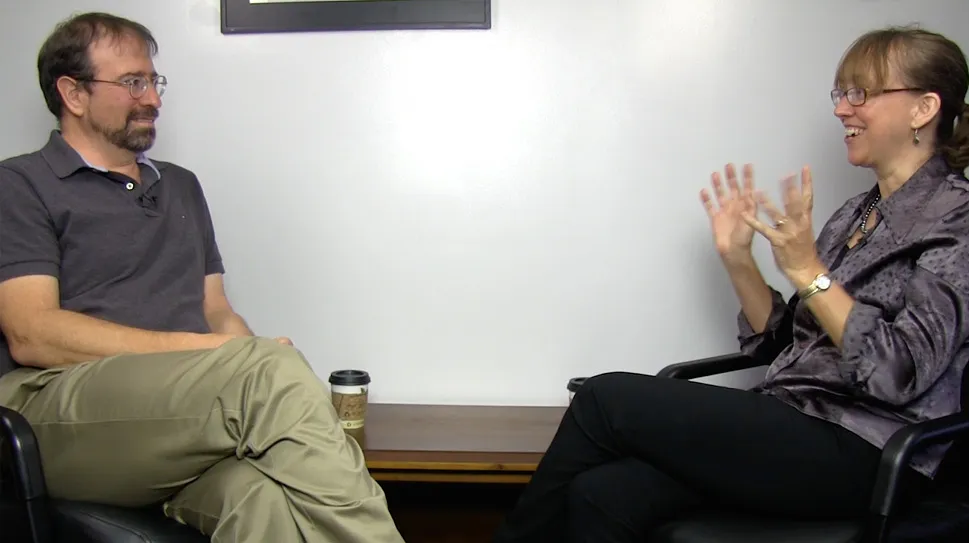![]()
The Conversation
![]()
I. From Ticks to Brains
Becoming a neuroscientist
HB: I’d like to start by talking about your scientific motivations—not necessarily regarding neuroscience, although I’d like to get there eventually—but just in terms of your general interest in science. Did you think to yourself, I’m going to be a scientist, ever since you were a little girl?
JG: I can trace it back to about age 12 when I saw a program on NOVA about the brain. It had three-dimensional views of neurons and little twinkling lights travelling along the axons of the neurons and all that. I just remember thinking, That’s really cool. That’s what I want to do.
HB: So you were particularly attracted to neuroscience.
JG: That’s right. But when I got to college, I thought, Well, I was only 12 when I developed this interest. I should make sure that I try other things. I was ready to change my mind if something else came along.
HB: And did you actively try other things? You went to Princeton for your undergraduate work, right?
JG: I did, yes.
HB: Were you in a neuroscience-oriented program right from the get-go—biology, presumably?
JG: Well, the biology program was broader than that. At Princeton everyone does a senior thesis, which you can get started on well before your senior year. I got really interested in behavioural ecology: how animal behaviour relates to the ecological constraints that the animals are operating under.
I became involved in a project studying wild horses, examining what behavioural strategies they employed to enhance their ability to survive and reproduce.
HB: What are some of those strategies?
JG: Horses, like most animals, have an equal sex ratio at birth—an equal number of males and females. But the social structure is that there’s usually one male associated with a group of females. So by the time they get to adulthood, there are naturally some males that are left out. These are called the bachelor males. I was interested in whether or not they were forming groups themselves—fraternities, if you will—of “left-out male horses”; and, if so, what advantages they were obtaining.
HB: So what did you find out?
JG: Well, I didn’t stay in the field, so I can’t say for sure how it turned out after that. But it looked like when they were in groups they were able to go to parts of the environment where the food was better and maybe hold their own a little bit more against the harem stallions, those males who are grouped with multiple females. The bachelor males were able to hold their own against the stronger males a little bit more successfully when they were congregating in groups.
HB: Do these bachelor males ever take on the harem stallions? Do they ever think, Well, there are 10 of us and there’s only one guy with all the mares. We can push him away?
JG: If they did, I didn’t see it. They probably do, because sometimes there’s turnover; and you’ll find that a male who used to be in charge of the group is no longer in this position and somebody else has come in.
In fact, I shouldn’t say they’re really “in charge”. It’s one male and multiple females, but it looks like the females are really driving the show. They’re the ones deciding where to go, what to eat, and so forth, while the male is more or less just tagging along, trying to keep the other males away.
HB: Interesting. Anyway, behavioural ecology was a real interest of yours, but then at some point you decided that it wasn’t as interesting as neuroscience. Tell me how that happened.
JG: Well, doing that kind of fieldwork is really hard. You’re camping on a barrier island, you’re living in a tent, and you’re spending 10 or 12 hours a day out in the hot sun.
HB: Where did all this happen?
JG: This was on the Outer Banks of North Carolina.
HB: There are wild horses on the Outer Banks?
JG: Yes, there are about a hundred wild horses on this particular island. They’ve been there since Spanish galleons were shipwrecked. It’s beautiful out there.
But I’d be sitting there on my little stool with my notebook, and between taking notes, I’d look down at my legs and start picking off all these ticks, which was pretty unpleasant. So I thought to myself, Hmm, the brain is really fascinating. I think I’ll go back to that.
HB: Sounds understandable. And at the time, did you have any particular research inclination with respect to neuroscience, or was it more a case of just being generally fascinated by the brain?
JG: As it happens, the first things that I learned about were the things that really grabbed my attention, but because they were first I wasn’t sure that I wasn’t going to be equally interested in other topics. So I sort of circled around and tried a few other things before coming back to what I was first interested in, which was how space is represented in the brain: how we know where stimuli are located, how we reconcile information about where visual stimuli are located with information about where sounds and things touching you on your body are located.
I was fascinated by how your brain puts together all that different kind of information to give you a coherent sense of the world, a sense that you’re moving around through one environment, independent of whatever the underlying sensory detection systems might be.
![]()
- How influential do you think science-oriented films or television shows, such as the one Jennifer describes in this chapter, are to motivating children to become scientists? Should we have more of them?
- Are scientists born or made?
![]()
II. Historical Background
On the shoulders of giants
HB: This brings us to your book, Making Space: How the Brain Knows Where Things Are, which I understand is based upon courses that you’ve been teaching here at Duke.
JG: That’s right. I teach about perception and the neural basis of perception, and I focus on the spatial aspects of perception.
HB: One of the things that I really enjoyed about it is that it has all sorts of scientific detail in it. I should emphasize that it’s a book that’s deliberately written for a general audience, but it nevertheless manages to do more than just talk vaguely in a high-level way about concepts—which, to be honest, is what I had expected.
In particular, the book forced me to confront all sorts of things that I had previously not thought about, concepts that I had taken for granted. Right at the very beginning, for example, you talk about how we actually see things.
I knew that we have photoreceptors in the eyes—which is roughly equivalent, I now recognize, to saying that our eyes are the things that we use to see. In other words, light comes in and impinges on our eyes, and those photons get converted to a current, and that goes to the brain, and that’s how we see. That was what I knew before I opened your b...

